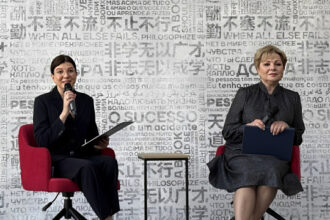The Tate Modern became more popular than anyone could have predicted when it first opened. With the Switch House, its extension opening on June 17, the London art museum promises weird encounters and a touch of feminism.
“All these cafes, where is the art?” asks an elderly lady, looking at a green giant wall display that directs visitors around the newest exhibition space of the Tate Modern in London. “It is right here,” says her senior companion, pointing at a sign right next to it.
The couple is among the few lucky people allowed to visit the Switch House before it officially opens to the public on June 17.
At the sight of the 10-storey building designed by the Swiss architecture office Herzog & de Meuron, one could have also answered that woman’s question with a simple: “Art is everywhere here.”
Concrete winding staircases, bricks interlaced in mesh-like patterns and large windows cascading light into spaces that challenge traditional definitions – somewhere halfway between a hallway and a gallery.
The architects of the project definitely have “a significant degree of understanding about the philosophy of showing art at the Tate,” says Frances Morris, director of the Tate Modern.
A new home for performance art
Flexible spaces were needed to display a great range of large-scale contemporary works. Previously, an installation such as Ai Weiwei’s seven-meter-high (23-foot) “Tree” could only fit in the massive Turbine Hall.
“The new building gives us a home for the work we have been trying to do for the past decade,” says Catherine Wood, curator at the Tate for performance art.
Contemporary art combining live performance, film and multimedia installations has long struggled to find proper exhibition spaces in traditional museums. The new Switch House, equipped with high-tech sound systems, lighting rigs and black boxes for film screenings, will definitely fill the void.
When art visits the visitors
With apps, free WiFi and interactive digital displays, the Tate Modern has always been a vanguard of audience participation.
Now the five million visitors per year can expect even more interaction: “The art might visit them as much as they might visit the museum and the art,” says curator Catherine Wood.
Minutes later, Wood is interrupted by a group of performers humming the opening score of the Star Wars movie. As a direct demonstration of what the curator had just been talking about, the same performance group starts asking visitors to take part in a constellation they are forming.
Focus on women
Some things will stay the same at the Tate Modern though, assures Wood. “We are not giving up on the idea of showing art work through time and telling a story of how they connect,” she says.
A dash of revolution can nevertheless be felt here too, at least for gender equality: With Frances Morris as the Tate Modern’s first female director, exhibitions at the Tate Modern will focus more on women in the arts.
“Women throughout the 20th century were denied access to all sorts of professional cultural structures,” says Morris. “They have not been celebrated in the same way that their male peers have been celebrated.”
As an illustration of this, a major upcoming exhibition in July features Georgia O’Keefe, whose work has been degraded by some as mere “flower paintings.”
Among other new projects, a whole floor at the Switch House will be dedicated to the Tate Exchange, set to start this September. Public radio, NGOs and educational institutions will be working with artists-in-residence. “It is an experimental space,” says Tate Modern director Morris. “It is impossible for me to say what it is going to look like.”
When brick lets in light
The whole extension project cost 260 million pounds (329 million euros, $368 million) and was made possible through extensive funding.
The architects Herzog and de Meuron had already been put in charge of the initial design of the Tate Modern in the 1990s, based on a conversion of the building known as the Bankside Power Station, built by British architect Sir Giles Gilbert Scott, famous for designing the iconic red telephone booth.
Five years after the Tate Modern opened in that building in 2000, the Swiss architects were already commissioned to design an additional building that would offer 60 percent more exhibition space for the gallery.
Instead of sleek glass fronts that have become ubiquitous in urban architecture, they decided to return to a Tate-iconic and trusted material: the London brick. “We pushed the brick to the next level,” says Mergenthaler, a partner architect at Herzog & de Meuron.
Instead of building a solid wall with these bricks, the architects encased the building in a way that reminds of knitted mesh. “It is perforated, so it filters sunlight,” says Mergenthaler.
Art as an experience was well reflected by the ideas Herzog & de Meuron brought into the project. “The fact that you can sit on the architecture, we like that very much,” says Ascan Mergenthaler, referring to the little window benches people can sit on.
A cultural shift for London
As one of the four nationwide Tate institutions, the cultural shift at the Tate Modern rubs off on other institutions as well – even on London’s government.
“For too long, culture has been a nice-to-have,” said the recently elected Mayor of London Sadiq Khan after his first visit of the new Tate Modern.
Now he wants to put culture at the heart of his administration: “To be a world city, London needs to be a creative city,” he declared, adding that in this respect, “the Tate Modern is a pioneer.”
As the new wing opens, this pioneer will definitely continue to influence – and surprise – the world.




